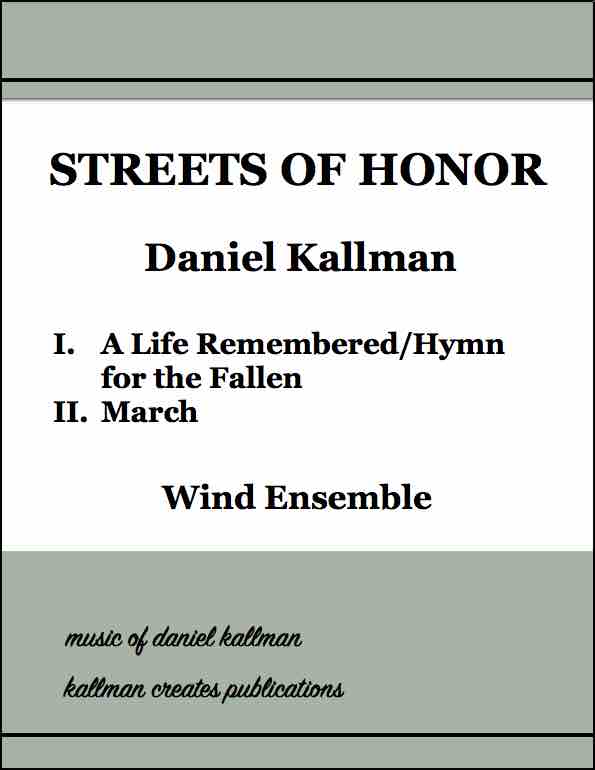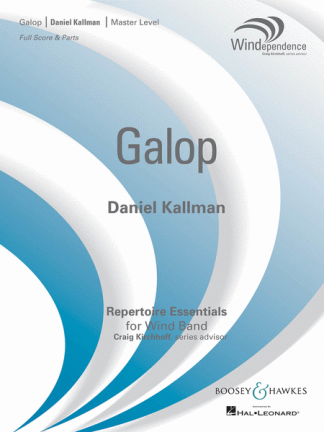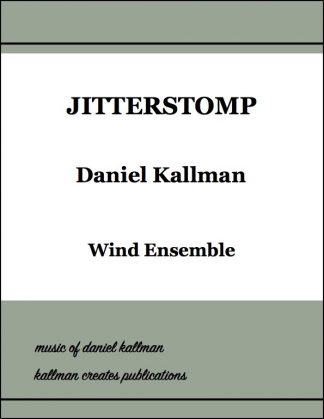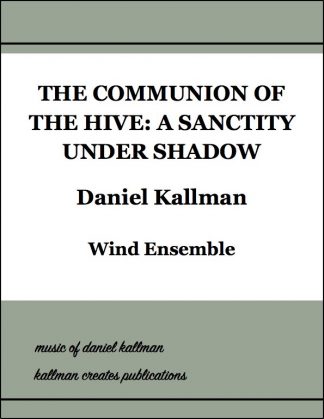Description
![]() Kallman Creates Publications
Kallman Creates Publications
Wind ensemble. Duration: 15’00”
The two movements are: I. A Life Remembered/Hymn for the Fallen, and II. March.
Streets of Honor March is also available separately.
Listen
View
View Mvt. I: A Life Remembered/Hymn for the Fallen
Composer’s Notes
Program notes from premiere performance:
In the spring of 2005, I was contacted by Trygve Skaar regarding the desire of the city of Appleton, Minnesota for a new musical composition to honor the memory and service of area military veterans, particularly those for whom many of Appleton’s streets have been named. As I came to know more about the history of military service from the citizens in this part of the state, I was eager to accept the commission and compose for the 34th Infantry Division “Red Bull” Band.
It was initially proposed that a patriotic march would be an appropriate form for the work, but as more funding became available through the generosity of the college, community and high school bands who have agreed to support this endeavor, a more extended composition became possible. In July 2005, Trygve and I traveled to Appleton where we met with representatives of the Martinson Foundation and several others in the community, including veterans of World War II. We visited the Veterans Memorial and drove down several of the streets bearing the names of the local heroes. We shared lunch together where I learned more of the history of the Minnesota National Guard in the Appleton area particularly relating to World War II. I received a copy of the centennial newspaper which had several articles from the first half of the 1940s. Erling Kolke also gave me his novel Streets of Honor and copies of the recorded interviews that he had conducted as research before writing the book. These were all very helpful in my preparation for composing the music.
At this point the challenge became how to format the composition. Because so much of the history of the National Guard in the Appleton area pertains to World War II, this became the focus of my attention. Which aspects or events of these soldiers’ short lives should be emphasized in a larger scale piece? In the end, I decided on a two movement format. The initial extended movement is in several distinct sections. The final movement is the march which was originally proposed.
The composition begins with a flourish, a celebratory fanfare in praise of the freedoms enshrined in our Constitution for which these young men made the ultimate sacrifice. Three short scenes of childhood make up the next section: a pastoral theme in keeping with the rural setting that most of these local residents enjoyed as children, followed by frolicking music of playtime, and finally a short placid lullaby in the solo flute. It is as if we have just spent a day in the life of one of these children during the innocent years before being called away to the war from which they would not return.
As the lullaby subsides, a faint call to battle is heard, and the child awakens as an older youth in a world under the shadow of what at that time was still a distant war. As the drums and brass draw closer, we call to mind the inevitability of the situation into which fate called these young people. With patriotic fervor, the drums fade to the distance as the soldier marches off to war. A lonely oboe solo reminds us of the deep sorrow felt by loved ones left behind who know that this may be the final time that they see their friend, child or spouse. As the oboe solo leads into the transition to the hymn, grief is gradually replaced by resignation and acceptance. The solace of the hymn reminds us of the faith which sustained friends and family members and helped to heal the wounds of loss for the many decades that followed the war even to this day. The hymn builds to triumphant strains and brings the first movement to a close.
In the second movement my goal was to convey themes of nobility, pride and heroism which I believe are essential components in all patriotic marches. A brief fanfare again introduces this movement which otherwise follows the basic format of most military marches in the Sousa tradition.
It is obviously not the intent of this work to make any kind of a statement about war itself, but today as this country again debates the necessity of armed conflict, the freedom that allows such a debate to take place can be traced back in no small part to the veterans whom we honor here today as well as those who currently serve in the military. Regardless of where we fall in the political spectrum, as Americans we should stand united in supporting those who choose to put on the uniform.
Streets of Honor was commissioned by a consortium of sponsoring organizations. Chief among them is the Martinson Foundation of Appleton. The many bands who have contributed financially to the creation of the work are listed below. I am indebted to the support of the foundation and these ensembles and their conductors for agreeing to be a part of this consortium. Each ensemble will receive a copy of the musical score and parts and has agreed to perform the work at least once in the next three years.
Albany High School, Craig Vogl, conductor
Bethel University, Steven Thompson, conductor
Bloomington Jefferson High School, Daniel Fretland, conductor
Cambridge-Isanti High School, Eric Anderson, conductor
Eagan High School, Thomas Maeck, conductor
Eden Prairie Community Band, Thomas Maeck, conductor
Gustavus Adolphus College, Douglas Nimmo, conductor
Lac Qui Parle Valley High School, Kim Omland, conductor
Minnesota State University-Mankato, Amy K. Roisum Foley, conductor
Rosemount High School, Steve Olsen, conductor
Saint Anthony Village High School, Andy Erickson, conductor
Saint Cloud State University, Richard Hansen, conductor
Saint Olaf College, Timothy Mahr, conductor
Spring Lake Park High School, Brian Lukkasson, conductor
Southwest Minnesota State University, Terry Beckler, conductor
Swift County Community Band, Wanda Dagen, conductor
University of Minnesota, Craig Kirchhoff, conductor
University of Minnesota-Morris, John Stanley Ross, conductor
University of Saint Thomas, Matthew George, conductor
Streets of Honor March performed in Iraq:
Here is a letter I received July 9, 2009 from Trygve Skaar, Conductor and Commander of the Minnesota 34th Infantry “Red Bull” Band:
Dan,
I hope you are well – please put this update on your website if you wish! I just wanted to share the great news with you – the performances went great and the march was a huge hit!! We just did this with a 76 piece band in Iraq!!!!!
The 34th Infantry Division Band is currently serving in support of Operation Iraqi Freedom and stationed in Basra, Iraq. Soldiers from the 34th ID “Red Bull” Band combined with Soldiers from 3 other deployed Army Bands in a historic event to entertain Soldiers throughout Iraq. Musicians from the 34th ID Band, 25th ID Band from Hawaii, 1st Cavalry Division Band from Fort Hood, Texas and the 56th Army Band from Fort Lewis, Washington combined to celebrate our Nations Independence Day. This was the first time that deployed Army Bands have combined forces to present a concert in a deployed setting. In addition to this concert tour, all of the Bands simultaneously performed throughout Iraq for Soldiers and Coalition Forces with Rock Bands, Brass Quintets and other musical performance teams. The combined concert culminated in Baghdad in front of Al-Faw Palace on July 4th where the combined band of 76 Soldier Musicians performed patriotic classics and entertaining standards and celebrated our nations independence. Dan Kallman’s Streets of Honors March was performed in this program and conducted by 34th ID Band Commander, CW3 Trygve Skaar. The story that Streets of Honors tells of the sacrifice that small town America has given for our freedom and the tradition of Appleton, Minnesota honoring its fallen heroes by naming its city streets with their name resonated with the Soldiers we performed for. Thank you Dan for creating such a great piece for our repertoire!
Trygve R. Skaar
CW3, AG, USA
34th Infantry Division “Red Bull” Band
Commanding
COB Basra, Iraq MND-S




